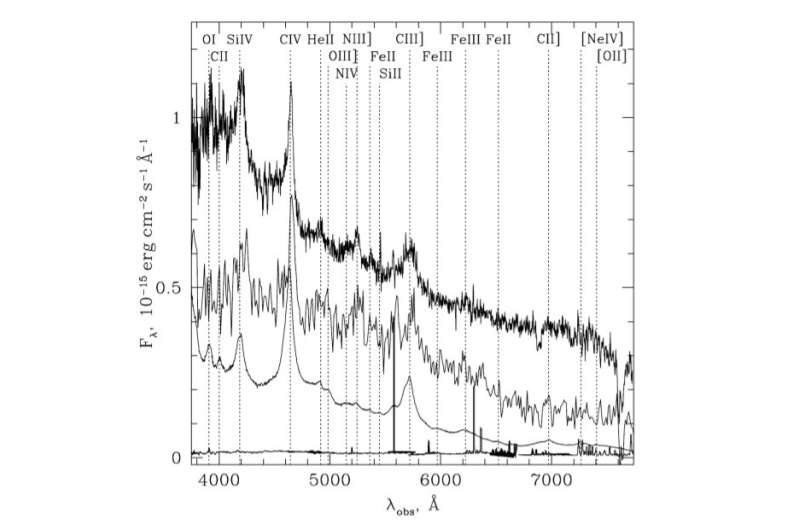October 5, 2021 report
Periodic variability of quasar QSO B1312+7837 identified by researchers

Using the Rozhen National Astronomical Observatory (NAO) in Bulgaria, astronomers have performed long-term monitoring of the quasar QSO B1312+7837 and have detected a periodic variability of this source. The finding is reported in a paper published September 28 on arXiv.org.
Quasars, or quasi-stellar objects (QSOs) are active galactic nuclei (AGN) of very high luminosity, emitting electromagnetic radiation observable in radio, infrared, visible, ultraviolet and X-ray wavelengths. They are among the brightest and most distant objects in the known universe, and serve as fundamental tools for numerous studies in astrophysics and cosmology.
For instance, quasars have been used to investigate the large-scale structure of the universe and the era of reionization. They have also improved our understanding of the dynamics of supermassive black holes and the intergalactic medium.
At a redshift of about 2.0, QSO B1312+7837 is a quasar showing typical broad emission lines. Its mean magnitude is about 16.4 mag, which corresponds to an absolute magnitude of −30.1 mag. This is about 3.5 mag brighter than the mean absolute for quasars at the same redshift Previous observations of QSO B1312+7837 have detected no signs of short-term variability of this source.
However, a team of astronomers led by Milen Minev of the University St. Kliment Ohridsky in Sofia, Bulgaria, now reports the detection of periodic variability of QSO B1312+7837. The finding is based on the data from a 15-year-long monitoring of this quasar using NAO's imagers equipped with standard photometric Johnsons-Cousins UBVRI filters.
"We report here the first results from a 15-year-long variability monitoring of the z=2.0 quasar QSO B1312+7837," the researchers wrote in the paper.
The study found a variation in the apparent brightness of QSO B1312+7837, with a probable period of 2,214 days (about 6.13 years). These luminosity changes have an amplitude of about 0.2 mag, superimposed on a gradual dimming at a rate of approximately 0.55 mag per 100 years.
The astronomers try to find mechanisms responsible for such variability. They assume that orbital motion of two supermassive black holes (SMBHs) as a result from a recent galaxy merger is the most plausible explanation. In general, SMBHs dominate the kinematic evolution of the central regions of galaxies, and affect the evolution of their stellar populations.
The researchers added that further X-ray spectroscopic observations of QSO B1312+7837 are required in order to probe directly the orbit, mass ratio and the dominant orbital decay mechanism for this assumed SMBH binary.
"The binary SMBHs evade detection for a number of reasons: because the velocity difference is smaller than the intrinsic width of the emission lines or because the offset nuclei are too close to be resolved with the existing instrumentation etc. Other techniques require competitive observing time at the few X-ray missions or moderately high resolution high multiplexity vast spectroscopic surveys," the authors of the paper explained.
More information: M. Minev et al, Periodic variability of the z=2.0 quasar QSO B1312+7837. arXiv:2109.13817v1 [astro-ph.GA], arxiv.org/abs/2109.13817
© 2021 Science X Network





















